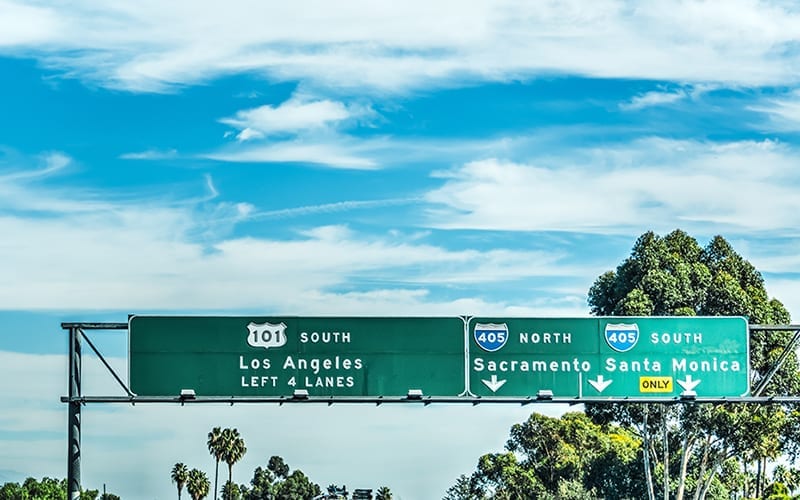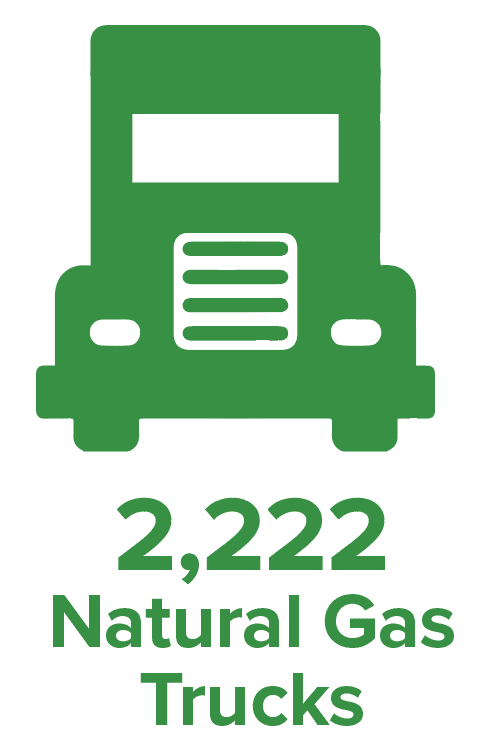California has the worst air pollution in the nation and diesel trucks are largely to blame.
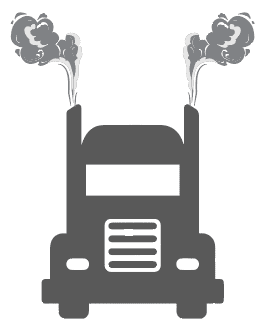
#1 Source of Emissions: Diesel Trucks – Emissions are increasing, despite California’s progressive vehicle emissions policy.
Heavy-duty (HD) diesel trucks are the backbone of California’s thriving goods movement economy, but they also deliver a lot of negative impacts to the state. As the largest single source of emissions in California, HD diesel trucks cause smog and unhealthy air for 90% of Californians[1]. HD diesel trucks emit NOx (oxides of nitrogen) and diesel particulate matter (DPM), which can cause a range of health issues including asthma, cancer, heart disease, and premature death. These impacts are particularly pronounced in California’s many disadvantaged communities (DACs) which are already overburdened by HD diesel truck emissions. In addition, HD diesel trucks are one of North America’s largest and most rapidly growing sources of climate-altering greenhouse gas (GHG) emissions which are detrimental to clean air.
California is facing several near-term deadlines to meet the minimum standards set by the federal government for clean and healthy air. Southern California only has until the end of 2022 to significantly cut smog-forming ozone emissions in order to reach these minimum federal requirements. Failure to meet these federal regulations can trigger fines and penalties, including withholding billions of dollars of federal highway funds. Of course, this is all in addition to the deadly toll diesel truck exhaust continues to take on the health of thousands of Californians on a daily basis.
Reducing diesel truck emissions is the only way that California can meet its clean air objectives. The state must find a way to get as many diesel trucks off the road as possible, and as quickly as possible, while ensuring industry can continue to thrive and grow the economy. With increasingly limited resources to achieve these multiple goals, the agencies responsible for providing healthy air for all Californians – especially those in DACs – must pursue the most immediate and most cost-effective solutions available. There is simply no other choice.
So how do we get there?
To answer this, let’s look at what a hypothetical $100 million government investment could achieve when using one of California’s most popular funding programs. Which option would you chose if both cost the same?
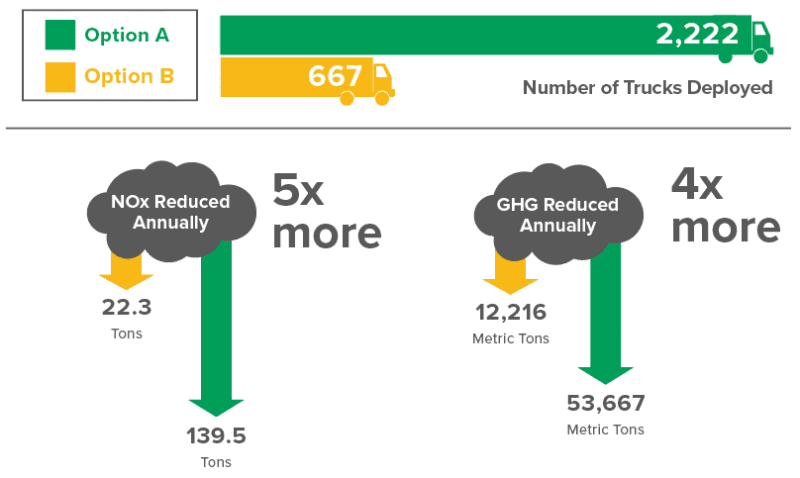
How to stretch our dollars the farthest.
Did you guess that “Option A” was a near-zero emission natural gas truck? If so, great job. Option B results from using battery-electric trucks.
It may be surprising to learn that natural gas trucks can deliver the most emissions reductions, even when compared to trucks that don’t have tailpipes. The simple side-by-side comparison above demonstrates how the cost-effectiveness of these investments can yield significant benefits in terms of the number of clean trucks deployed and overall benefits that can be immediately achieved.
Here’s how this was calculated. Using one of California’s most popular funding programs (HVIP), a heavy-duty battery-electric vehicle (HD BEV) is eligible for a $150,000 incentive per truck. With $100 million government investment, 667 trucks could be funded ($100,000,000 / $150,000 = 667 HD BEVs funded).
A HD BEV typically has a range of 100 to 150 miles per charge and drives an estimated total of 12,000 miles per year[2]. Using these assumptions, the state could achieve the nitrous oxide (NOx) and greenhouse gas (GHG) emissions shown below.
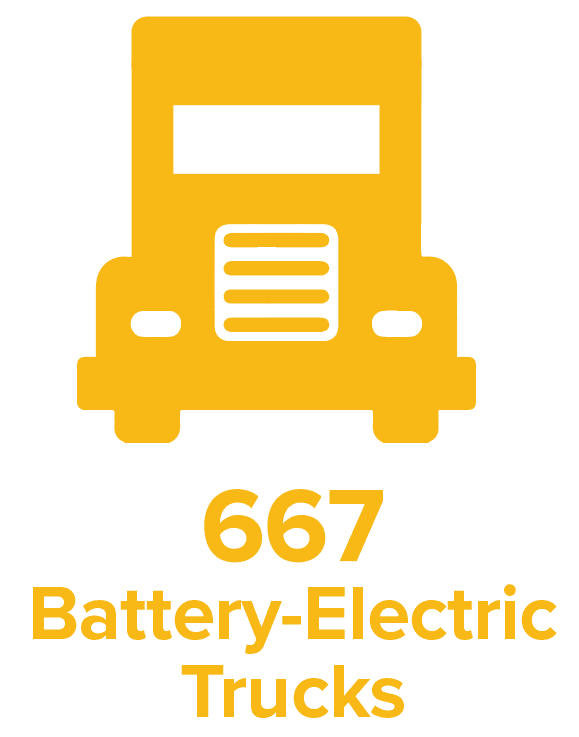
22.3 12,216
Total Annual Tons of NOx Reduced Total Annual Metric Tons of GHG Reduced
Through the same HVIP program, a heavy-duty natural gas vehicle (HD NGV) is eligible for a $45,000 incentive per truck. The lower incentive is because HD NGVs have a much lower upfront purchase cost ($160,000 for a natural gas truck vs. $300,000 [short-range] to $605,000 [long-range] for battery-electric trucks, pre-FET and sales tax[3]). With $100 million in government investment, the state could fund 2,222 natural gas trucks ($100,000,000 / $45,000 = 2,222 HD NGVs funded).
A HD NGV typically has a range of 550 to 700 miles on a full tank. This additional range allows it to work much longer than can a HD BEV. Using the total potential daily range, a HD NGV can easily drive 150,000 miles or more per year. However, for consistency with the HD BEV calculation above, we’ve used a much more conservative estimate of 25,000 miles per year.[4] Therefore, with the same assumptions and formulas that were used for the HD BEV calculation, the associated emissions benefits of funding natural gas trucks are confirmed to be four to five times higher:
139.5 53,667
Total Annual Tons of NOx Reduced Total Annual Metric Tons of GHG Reduced[5]
Since most people don’t think in terms of “metric tons of emissions,” the example below translates the greenhouse gas emission benefit into something more relatable to our daily lives.

The ability to achieve major progress in clean air right now.
Ultimately, both electric and natural gas vehicle technologies will play important roles in California’s clean transportation future. Experts agree that there is no “one size fits all” solution to meet the diverse operational needs of all California fleet operators—from transit to delivery, goods movement, agriculture, construction, schools, utilities, refuse collection, and public works. If California wants to have a fighting chance in achieving its clean air deadlines and bringing healthy air to millions of Californian’s living with persistent smog, maximizing near term actions and scaled deployments of cost-effective clean technology will be absolutely critical.
A few vehicle manufacturers are starting early pilot projects for HD BEVs. Unfortunately, for the large trucks that haul our goods and produce the most amount of emissions, scalable HD BEV solutions are not commercially available today. In fact, many manufacturers have stated that in the first several years of introducing HD BEVs to market, only a few hundred trucks will be manufactured each year, and deployment opportunities will be significantly restricted by the lack of an available charging infrastructure.
It’s no surprise that many industry experts have stated that HD BEVs will not be utilized on a wide scale for at least 10 years or more given the limited availability of vehicles, high purchase costs, and the need to develop an entire support ecosystem (e.g., high-powered public and private charging infrastructure, utility rate programs, dealership sales and service, parts distribution, etc.). With millions of HD diesel trucks on U.S. roadways, HD BEVs will be unlikely to make a significant dent in our air quality and climate challenges in the in the immediate term. Fortunately, however, HD NGVs are available and viable, and ready to make a difference, today, and at scale.
HD NGVs are commercially available today from 10 major truck manufacturers—including Freightliner, Volvo, Kenworth, Mack, Peterbilt, and others. With these well-established brands also comes robust sales and service networks already in place to support HD NGVs at scale – especially in California. With the demonstrated power, performance and reliability required to meet fleets’ rigorous daily operations, there are more than 175,000 NGVs in operation across the United States today, which are supported by a strong and growing network of fueling stations. Given their widespread commercial availability, proven operations, and with the entire support ecosystem already in place, the continued scaling up deployments of this clean air technology can take place immediately – an extremely important issue when trying to reduce emissions and protect human health as quickly as possible.
Ultimately, it’s critical that California continue to support market competition among all clean transportation technology solution providers—including natural gas, battery-electric, clean diesel, propane autogas, hydrogen fuel cell, and others. Competition accelerates technology innovation, and leads to improved operational, environmental, and cost performance.
With more limited financial resources available, prioritizing incentive funding to facilitate large volume deployments of clean transportation technologies that get the most bang for the buck is absolutely critical to achieving clean air and climate change mitigation as quickly, effectively and efficiently as possible.
Interested in Learning More About the Benefits of Natural Gas Trucks and Renewable Natural Gas (RNG)?
Keep Reading…
1. Natural gas truck emissions are practically undetectable.
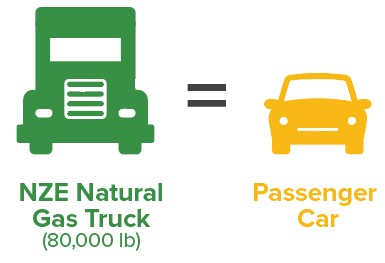
Equivalent NOx Emissions/Mile[6]
These emissions from HD NGVs are in fact so low that they are comparable to the emissions that come out of the tailpipe of a typical light-duty gasoline car on the market today – a truly amazing feat for an 80,000 truck!
2. Using RNG enables fleets to go beyond carbon neutrality and save money.
 The natural gas that fuels vehicles can be produced from a variety of renewable sources including wastewater treatment plants, food and green waste, landfills, dairies, and farms.
The natural gas that fuels vehicles can be produced from a variety of renewable sources including wastewater treatment plants, food and green waste, landfills, dairies, and farms.
Producing natural gas from these renewable sources provides an unmatched opportunity to capture the methane – which is a greenhouse gas – that would have otherwise been emitted into the atmosphere through each source’s natural decomposition cycle. By capturing this methane and using it to displace diesel fuel in a HD truck, RNG can have a “negative” carbon intensity (i.e., beyond carbon neutrality).
A 2020 report from Lawrence Livermore National Labs found that for California to achieve its 2045 carbon neutrality goals, investments in carbon negative actions will be required[7] . RNG is readily available to achieve such actions, today.
Not only are fleets using low carbon RNG helping to immediately reduce large volumes of climate change gases, they are also able to further lower their fuel cost via the financial credits afforded under the federal RIN Program and California’s LCFS Program.
3. The U.S. can produce large volumes of RNG.

More than 75% of natural gas used for transportation in California already comes from renewable sources[8]. The production of renewable natural gas (RNG) in California continues to grow significantly.
Additionally, a recent study confirmed that the total amount of RNG available in the U.S. could ultimately offset 75% of all current diesel fuel used in the national transportation sector. [9]
4. Natural gas trucks give us the ability to tackle California’s air pollution today.
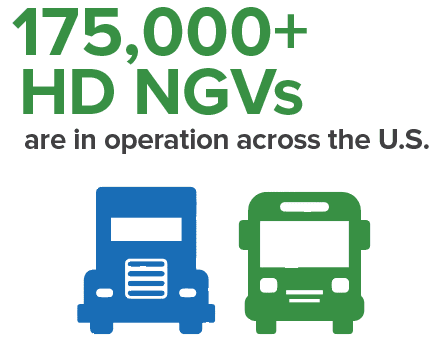 HD NGVs are commercially available today from 10 different major truck manufacturers—including Freightliner, Volvo, Kenworth, Mack, Peterbilt, and others. With these well-established brands also comes robust sales and service networks ready to support HD NGVs, especially in California where this clean air technology has been increasingly and successfully used for more than two decades.
HD NGVs are commercially available today from 10 different major truck manufacturers—including Freightliner, Volvo, Kenworth, Mack, Peterbilt, and others. With these well-established brands also comes robust sales and service networks ready to support HD NGVs, especially in California where this clean air technology has been increasingly and successfully used for more than two decades.
Given HD NGV’s widespread commercial availability, proven operations, and with the entire support ecosystem already in place, the continued scaling up deployments of this clean air technology can take place immediately – an extremely important issue when trying to reduce emissions as quickly as possible.
Visit the CNGVP website to learn more.
Sources:
[1] American Lung Association, 2019 State of the Air Report. https://www.lung.org/media/press-releases/20th-sota-ca
[2] California Air Resources Board, 2019-2020 Clean Transportation Incentives Funding Plan, Appendix A. https://ww2.arb.ca.gov/sites/default/files/2019-09/fy1920fundingplan-appa.pdf
[3] 2018 Feasibility Assessment for Cargo-Handling Equipment, September 2019. https://www.gladstein.org/wp-content/uploads/2019/09/Final-CHE-Feasibility-Assessment_August-2019-Master.pdf
[4] California Air Resources Board, 2019-2020 Clean Transportation Incentives Funding Plan, Appendix A. https://ww2.arb.ca.gov/sites/default/files/2019-09/fy1920fundingplan-appa.pdf
[5] This emissions analysis in based on the California Air Resources Board’s assumptions from their FY19-20 funding plan, including using the average carbon intensity of RNG consumed in California in 2016 based on Low Carbon Fuel Standard data.
[6] Based on testing conducted by the University of California at Riverside on a 12L NZ natural gas engine (https://ucrtoday.ucr.edu/wp-content/uploads/2018/08/CWI-LowNOx-12L-NG_v03.pdf) which showed NOx emissions ranging from 0.02 to 0.11 g/mi. By comparison, the average MY2020 passenger car has NOx emissions of 0.025 g/mi (per EMFAC 2017).
[7] Getting to Neutral: Options for Negative Carbon Emissions in California, January 2020. https://www-gs.llnl.gov/content/assets/docs/energy/Getting_to_Neutral.pdf
[8] Calculation based on California Air Resources Board 2018 Low Carbon Fuel Standard Data
[9] American Gas Foundation, December 2019, Renewable Sources of Natural Gas: Supply & Emission Reduction Assessment Study. https://www.gasfoundation.org/wp-content/uploads/2019/12/AGA_3894-RNG-2-Pager_V-11.pdf

